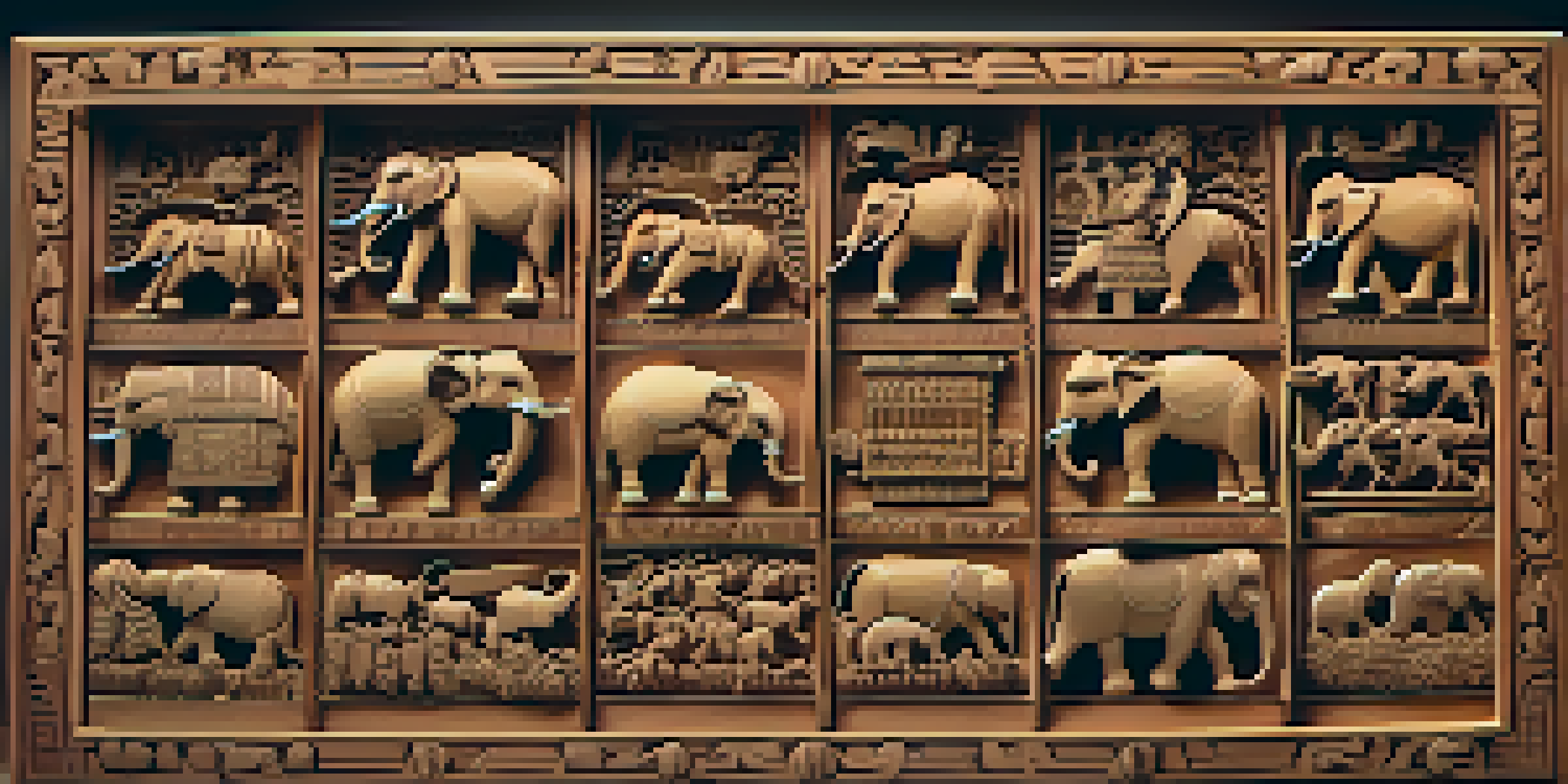The Legacy of Chaturanga: The Ancient Indian Board Game

The Origins of Chaturanga in Ancient India
Chaturanga, often hailed as the predecessor of modern chess, originated in India around the 6th century AD. The name 'Chaturanga' translates to 'four divisions of the military,' which reflects the game's strategic essence, incorporating infantry, cavalry, elephants, and chariots. This connection to military tactics not only made it a popular pastime but also a tool for teaching strategy and critical thinking.
Chess is a war over the board. The objective is to crush the opponent's mind.
The game spread across the Indian subcontinent and into Persia, evolving along the way. As it made its way to different cultures, it picked up variations and adaptations, which eventually laid the groundwork for chess as we know it today. It’s fascinating to think how a simple board game could traverse boundaries and influence countless civilizations.
Chaturanga's creation was a significant cultural achievement, showcasing the blend of art, warfare, and intellect. Even today, elements of its gameplay can be seen in various board games, highlighting its enduring legacy in the world of strategic gaming.
Understanding the Gameplay of Chaturanga
The gameplay of Chaturanga is intricate yet engaging, designed to challenge players' strategic skills. The board is typically an 8x8 grid, similar to a chessboard, where each player commands an army consisting of pieces with different movements and powers. For instance, the infantry moves forward one square like a pawn, while the elephants can leap over other pieces, similar to a bishop in chess.

One of the unique aspects of Chaturanga is its focus on the four military divisions, each representing different aspects of warfare. This not only makes the game varied but also allows players to develop distinct strategies based on their piece movements. Players must think critically about each move, considering both offense and defense.
Chaturanga's Historical Roots
Originating in India around the 6th century AD, Chaturanga reflects the strategic aspects of military tactics, influencing the development of modern chess.
As players engage in this intellectual duel, they learn valuable lessons about foresight and tactics. The game encourages players to anticipate their opponent's moves while remaining adaptable, making each session a dynamic experience filled with excitement and challenges.
Chaturanga's Influence on Global Board Games
The influence of Chaturanga extends far beyond India, having shaped various board games around the globe. After its introduction to Persia, it evolved into Shatranj, which further influenced the development of chess in Europe. This transformation showcases how cultural exchanges can lead to the evolution of games, reflecting the interconnectedness of human experiences.
The game of chess is not just an idle pastime; it is an intellectual battle that teaches us strategy and foresight.
As chess became popular in Europe, it absorbed elements from different cultures, yet the roots of its strategic gameplay can be traced back to Chaturanga. The core concepts of positioning, strategy, and the importance of each piece remain central to both games. This legacy continues to resonate with players, making Chaturanga a pivotal part of gaming history.
Even contemporary board games often incorporate strategic elements reminiscent of Chaturanga. Whether it’s through mechanics of movement or tactical decision-making, its essence lives on, proving that some concepts are timeless in the world of gaming.
Cultural Significance of Chaturanga in India
Chaturanga holds a special place in Indian culture, often representing intellectual prowess and strategic thinking. It's not just a game; it symbolizes the rich heritage of India, where art, culture, and intellect intersect. In many traditional settings, playing Chaturanga is seen as a way to hone one's mental faculties while engaging in a social activity.
Throughout history, Chaturanga has been referenced in ancient texts and literature, showcasing its importance in society. Kings and scholars alike embraced the game, using it to sharpen their minds and devise strategies for governance and warfare. This historical backdrop adds depth to the game, making it a cherished artifact of Indian culture.
Educational Benefits of Chaturanga
Playing Chaturanga fosters critical thinking and problem-solving skills, making it a valuable tool for personal development and education.
In modern times, Chaturanga has seen a resurgence, with many people rediscovering the joy of traditional games. It serves as a reminder of India’s rich gaming heritage, encouraging younger generations to engage with their cultural past while enjoying the thrill of strategic gameplay.
Chaturanga in the Digital Age
As technology advances, Chaturanga has found a new platform in the digital age. Various apps and online platforms now allow players to enjoy this ancient game with friends or against AI opponents. This accessibility has reintroduced Chaturanga to a global audience, making it easier for anyone to explore its complexities and strategies.
Digital adaptations of Chaturanga also allow for innovative gameplay, incorporating features like tutorials and multiplayer options. This has made the game more inviting for newcomers who may be intimidated by traditional formats. The blend of ancient strategy with modern technology creates a unique experience that respects the game's roots while appealing to today's gamers.
Moreover, online communities and forums have emerged, where enthusiasts discuss strategies, share experiences, and promote the game's history. This digital revival not only keeps Chaturanga alive but also fosters a sense of connection among players worldwide, bridging cultures through the shared love of this timeless game.
Educational Value of Playing Chaturanga
Playing Chaturanga is not just a recreational activity; it also offers significant educational benefits. As players engage in the game, they develop critical thinking, problem-solving, and strategic planning skills. These abilities are essential not only in gaming but also in real-life situations, where making informed decisions is crucial.
In classrooms, educators often use games like Chaturanga to teach students about strategy, mathematics, and history. By integrating gameplay into learning, students can grasp complex concepts in a fun and engaging manner. This hands-on approach encourages collaboration, as players discuss strategies and share insights with one another.
Chaturanga's Timeless Appeal
The game's inclusive nature allows players of all generations to connect and enjoy strategic gameplay, bridging cultural and historical divides.
Furthermore, playing Chaturanga promotes patience and discipline, as players must carefully consider their moves before acting. These qualities are invaluable in today's fast-paced world, where impulsive decisions can lead to negative consequences. By encouraging thoughtful gameplay, Chaturanga serves as a valuable tool for personal development.
Chaturanga: A Game for All Generations
One of the remarkable aspects of Chaturanga is its timeless appeal, making it a game for all generations. From children learning the basics of strategy to seasoned players refining their skills, Chaturanga accommodates everyone. This inclusivity fosters intergenerational connections, as families and friends come together to share in the joy of gameplay.
The simplicity of the game mechanics paired with the depth of strategy ensures that players of all skill levels can find enjoyment. Whether playing casually or competitively, the game offers layers of complexity that keep players engaged. This adaptability is a testament to its enduring nature, allowing it to thrive across different cultures and eras.

Ultimately, Chaturanga is more than just a game; it's a bridge between past and present, connecting players through shared experiences. By continuing to play and promote this ancient game, we honor its legacy while ensuring that future generations can enjoy its rich history and strategic depth.